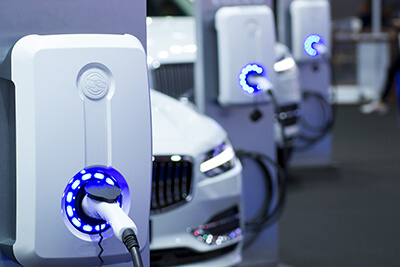
As available technology improves, buildings are designed to be smarter in order to keep pace with technological advances and new ways of working; sometimes, however, buildings need some help to keep pace with these demands.
The Davis Companies had just such a property in Cambridge, MA. They had renovated the existing 2-story property adding two additional stories and renovating and expanding the existing building to include a restaurant, workout room, game room and collaboration area for the tenants. Lots of light and open space were an important part of the design – meaning high ceilings and some areas with no ceilings in the building.
In the parking garage, electric charging stations were installed for the convenience of the tenants. An app easily installed on a cell phone was all that was needed to activate the charging station. In the lobby of the building, a monitor tracking public transportation was required by the City of Cambridge. This allows tenants and visitors to see the upcoming times of nearby trains and buses. As a very practical addition, The Davis Companies added the ability to see ride sharing and taxi arrivals on the screen to improve convenience for tenants.
The beautifully redesigned building had a problem, though. When the building opened, there was poor cell coverage in the parking garage and in the common areas. This meant that the charging stations could not be activated because the app would not work in the parking garage. In the common areas the beautiful, open, well-lit space was installed with energy efficient Low-E glass which can interfere with cell signals. As a result, the common areas had no cell service making it impossible to download music or listen to a podcast in the workout room or dial in a colleague for a virtual meeting; and it was impossible to get an Uber or call a cab.
The Davis Companies looked for a solution and found KTS. We were easily able to fix the communication problems with the installation of a BDA. A cellular Bi-directional antenna is comprised of three parts: a small antenna mounted outside the building, a signal amplifier which is typically housed in an IT or wiring closet inside the building, and internal antennas (dome or panel) which are strategically and discreetly placed throughout the inside of the building to boost the signal. The antenna is pointed at the nearest cell tower and receives the signal. It then directs the signal inside the building. It does not emit any signal of its own, it merely redirects the cellular signal.
In order to honor the aesthetics of this open space, KTS designed the placement of the dome antennae and the incorporated panel antennae to maximize cellular coverage while blending in with the interior décor. Read more about The Davis Companies’ story here.
Cellular BDAs are a simple fix to an annoying and common problem. They can be installed unobtrusively in your workspace and dramatically improve your communication. If your workplace has issues with poor cellular coverage contact us. We can evaluate your space and offer you practical cost-effective solutions to solve your problem.
